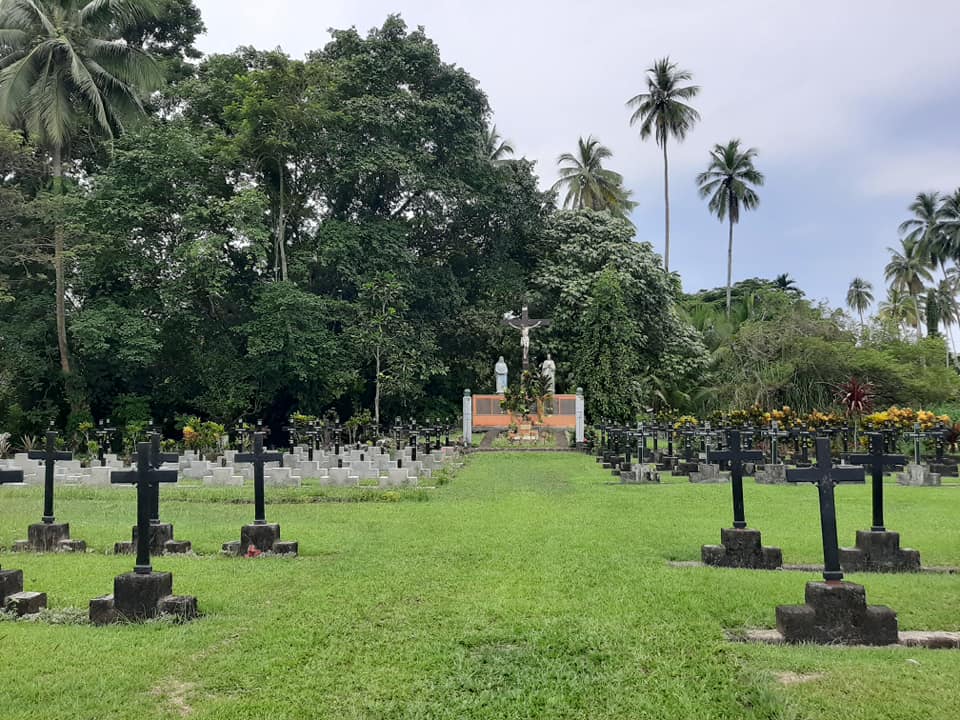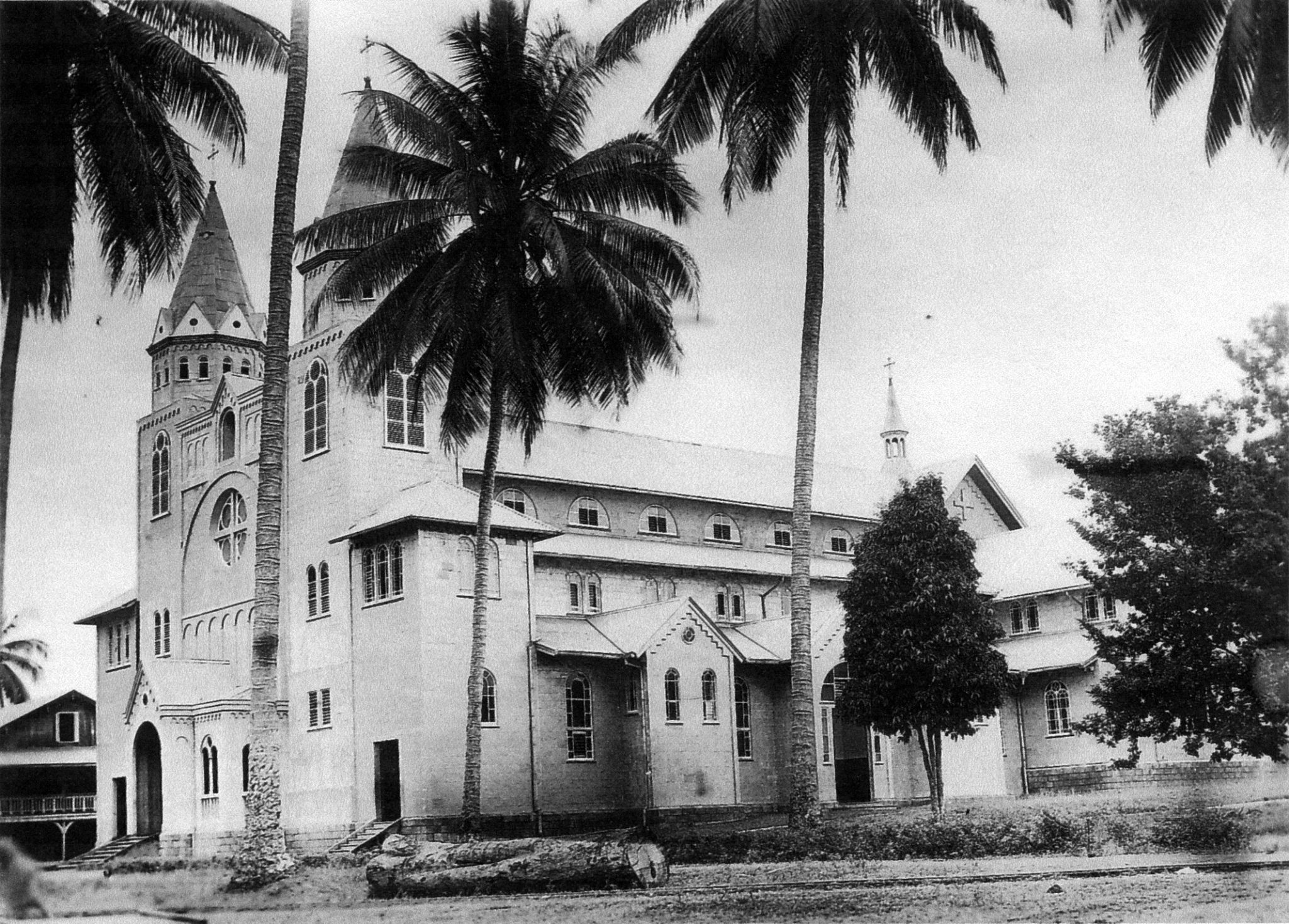“The loss of the Cathedral (in Alexishafen) was a tremendous psychological blow, particularly to Bishop Wolf,” Dr James Sinclair.
By KEVIN PAMBA
There is a cemetery in the grounds of the historic St Michael’s Catholic mission station at Alexishafen in Madang Province.

For Catholic Christians in this part of Papua New Guinea, this is where you go to appreciate the many missionaries and lay workers who gave their lives for the Word of God and for the betterment us who are alive and the generations to come.
Alexishafen is about 25-minutes’ drive up the North Coast Road from the provincial capital, Madang town whose old German name is Friedrich-Wilhelmshafen.
The cemetery is that of Catholic missionaries and lay workers who have passed on since the landing of the first six missionaries from Germany at the port of Friedrich-Wilhelmshafen on 13th August 1896 which is 125 years ago this month.
The pioneer six missionaries, all men, were from the German-founded Catholic congregation called the Society of the Divine Word or Societas Verbi Divini (SVD) in Latin. The six SVD missionaries led by Father Eberhard Limbrock 36, were Fr Franz Vormann, Fr Joseph Edweg, brothers Canisius Hautkappe (a mechanic by trade), Eustochius Tigges (carpenter and cabinet-maker) and Theodulph Schmidt (cook/tailor). The Founder of the SVD congregation, Fr Arnold Janssen (now Saint Arnold Janssen) appointed Fr Limbrock to lead the six-man team to Friedrich Wilhelmsafen in Kaiser Wilhelmsland (or German mainland New Guinea).
Not all missionaries are buried in the cemetery in Alexishafen, but their memories are remembered there. The bishop of Madang during World War II, Bishop Franz Wolf SVD is commemorated here on the cenotaph that acknowledges the missionaries who died during the War.
Bishop Wolf was among over 90 expatriate Catholic missionaries and lay workers across Madang Province were rounded up by the Japanese military in 1943 and held captive for many months in the hills of Gayaba inland from Alexishafen. The spot where the missionaries were held captive is now a scared site for the Catholics in the Archdiocese of Madang. The Catholics in Madang call the site “Maria Helpim”, which is Tok Pisin abbreviation for “Mary, Our Lady of Perpetual Help”.

The Japanese kept the missionaries in Gayaba to avoid them being spotted by the Allied Forced led by the Americans as white skinned people living in the area. While the missionaries were held kept in Gayaba, the bombing raids from the Allied Forces ensued and the Alexishafen mission station complete with its large Cathedral were destroyed on 1st September 1943.
One of the captives at Gayaba and survivors of the War Sister Siglinde Poboss SSpS recounted the bombing of Alexishafen and its cathedral in her memoir:
“On Sept 1, 1943 the magnificent Cathedral at Alexishafen with everything in it were destroyed.
“Nothing was left but a small part of the foundation and the broad concrete steps.
“One Host (a piece of Holy Communion) was still in the Tabernacle (of the destroyed Cathedral).
“Fr Luttmer just happened to be with the brothers on another island (off Alexishafen) that day.
“The Japanese regretted most of all that the beautiful organ was destroyed.
“Often before the (Japanese) soldiers had begged us to remove the large ‘gramophone’ from the church.”
The bombing of Alexishafen and its cathedral took place when the missionaries were still held captive at Maria Helpim.
The American airforces realized the Cathedral at Alexishafen was used by the Japanese to store ammunitions so they had little choice but to bomb it.
“The loss of the Cathedral was a tremendous psychological blow, particularly to Bishop Wolf,” wrote Dr James Sinclair in the 2019 DWU Press book, “Diwai: A history of Divine Word University”.
The Japanese later walked Bishop Wolf and fellow captivates from Gayaba to Bogia, which is a very long distance and then put on a boat and taken across to the mission station on Manam Island where joined Lutheran missionary captives and other lay people there, The captives were then transferred onto the Japanese boat Yorishime Maru and taken over to Wewak en route to Hollandia (present-day Jayapura in West Papua). As day light broke near the approach to Wewak harbour the American planes flying above spotted the Yoriskime Maru and bombed it and many missionaries were killed and the injured ones were taken on shore to Wewak and some died from their injuries afterwards.
The survivors were later taken to Hollandia (or Jayapura) and rescued by the American forces when the War ended in 1945. The cenotaph at Alexishafen remembers the missionaries (the SVDs and Holy Spirit sisters) who died in the War. Another group of missionaries based on Kairuru Island near Wewak and in Manus were taken on board the Japanese destroyer Akikaze and executed onboard as the ship sailed between Manus and Rabaul in March 1943. These missionaries included Bishop Loerks of Wewak six SVD priests, 14 SVD brothers, 18 Holy Spirit Sisters and three laymen all taken from Kairuru Island plus another 12 Catholic and protestant missionaries and one lay person taken on Manus.
The victims of the Yoriskime Maru bombing and the execution on board the Akikaze are remembered at the cenotaph in the Alexishafen cemetery.
In remembering the story of Maria Helpim, the Catholics in Madang acknowledge the role played by the missionaries in praying of the rosary and prayers of intercession to the Mother of Jesus Christ. The Catholic faithful in Madang province take a pilgrimage Maria Helpim at Gayaba every September but this was cancelled in 2020 and 2021 due to the onset of the COVID 19 pandemic.
The post-War bishop of the Madang, Archbishop Adolph Noser SVD is also buried next to the cenotaph of the missionaries who died in the War.
Archbishop Noser is credited for some of the key initiatives of the Church in this region in those post-War reconstruction years. Archbishop Noser was behind the planting of the seeds of a future Divine Word University by backing the establishment of DWU High School in 1968, which transition into Divine Word Institute in 1979 and University in 1996.
Mission records show that Archbishop Noser and his fellow planners in the Church planned to build a university in Madang as far back as 1958 but the colonial administration were not convinced that the indigenous Papua New Guineans were ready to take up university education at that time. So the Church settled for DW Catholic High School in Madang 10 years later in 1968, not long after the Australian colonial administration opened the University of Papua New Guinea in Port Moresby.
Archbishop Noser is also recorded in Church history as recommending to the Church hierarchy in the Oceania region to invite the Franciscan Capuchin missionaries from the United States of America to take up the new mission field in the frontier Southern Highlands District (now province) in 1955. Divine Word University remembers Bishop Noser with the PNG History collection within its Friendship Library named as the Noser Library.

On the afternoon of Saturday 14 August 2021, the Divine Word (SVD) missionaries located across PNG will gather at the mission cemetery at Alexishafen to “remember the departed souls”. The solemn commemorative event will be part of their celebration of 125 years of the presence of the SVD missionaries in the PNG mission field since 13 August 1896. The celebrations in Madang start on 9th August and end on 21st August 2021.
Dr Kevin Pamba PhD is based in Divine Word University, Madang. Dr Pamba joined DWU in January 2000.


